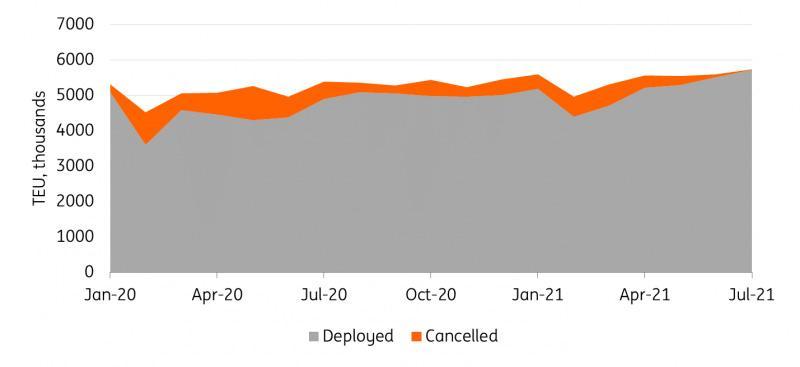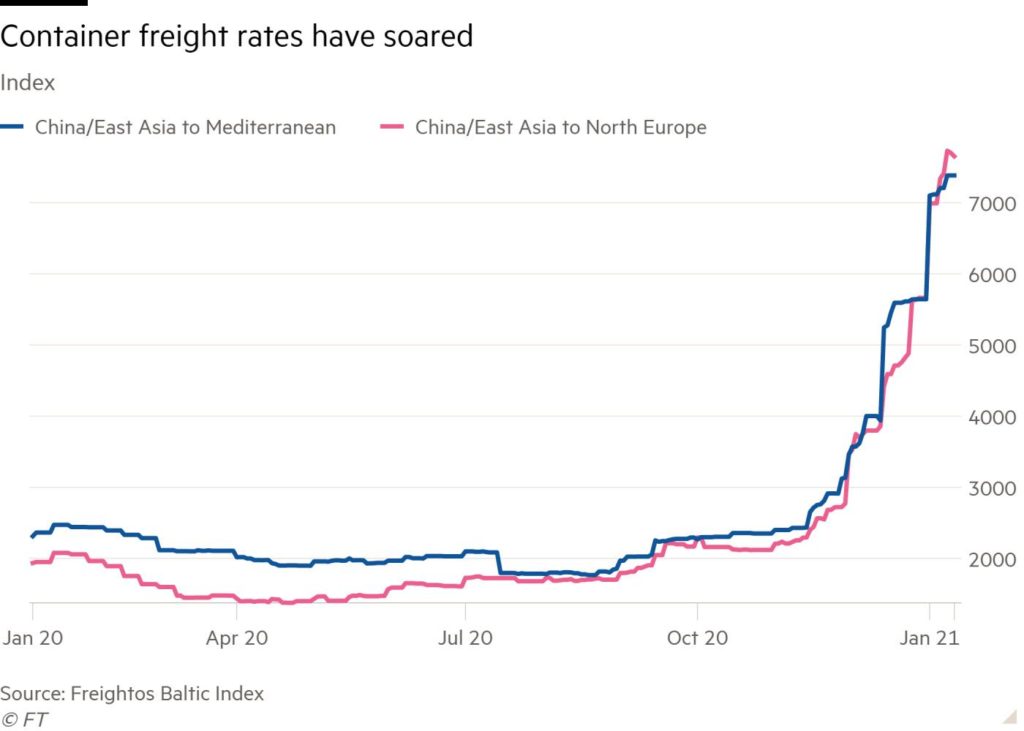Table of Contents
As the pandemic continues to affect the world in different ways, a big change that has come about is the increased dependence on shipping.
Rising shipping expenses have remained stubbornly in place for many businesses, making it difficult to manage finances efficiently.
Businesses have been left with few choices as they are sealed to high shipping expenses and contracts and have largely chosen to pass this expense on to the customer.
This is unfortunately not only true for their products, but their custom packaging too.
According to The Financial Times, The price for containers moving goods from China to the US and Europe has remained at a record high and is projected to increase over the next coming years.
As businesses continue to enter into contracts with higher than usual rates, it’s becoming apparent that higher freight costs may be here to stay.
Why are Shipping Costs so High in 2021?
2021 has seen skyrocketing shipping costs as pandemic-related delays and closures continue to disrupt supply chain and freight flow.
In addition, lockdown restrictions have been consistently slowing down global trade in general.
Paired with increased trade imbalances, tensions and shrinking manpower due to stay-at-home orders, let’s just say it’s easy to see why shipping costs have risen the way they have.
For example, ocean freight demand increased as air and ground methods became more challenging during the pandemic.
As ocean freight capacity decreases, rates remain high without much guarantee of transit times, making it difficult for many companies to even facilitate shipping their products and packaging out to customers on time.

While larger businesses have managed high shipping costs, small businesses have not had the same luxury as financial resources have been scarce. The increasing dependence on spot rates and price increases means that it’s difficult for small businesses to offer customers accurate shipping prices as the packaging they use is nearly 200% higher and time continues changing the cost for the worse.
It goes without saying that with limited capacity and increased demand, the shipping market is seeing a massive shift in pricing.
While big shipping firms can take advantage of the situation due to their large client volume, the same cannot be said for others.
For smaller businesses that aren’t able to negotiate contracts as well or don’t have the resources, have been facing real difficulties.
Price hikes and surcharges are often added to shipping costs due to weather, congestion, fuel, or other reasons, making it increasingly difficult for small business owners to keep costs down for customers and themselves.
How COVID-19 has Changed Consumer Behavior
There is little doubt that COVID-19 has changed much of consumer behavior.
Increased health concerns coupled with different lockdown restrictions worldwide have led to a major dependence on e-commerce and, of course, fast shipping.
More and more shoppers have moved to online retail, leading to an unprecedented uptick in activity and demand for goods.
With no access to malls or shopping centres, purchases have moved online across all sectors, including essential goods and groceries, but it’s clear that consumers are waiting to start shopping in more categories as restrictions continue to ease.

While online shopping has increased, trends show that the average amount being saved has gone up as customers continue to exhibit caution in their shopping habits.
But as lockdowns ease and vaccination rates rise, research shows that those savings have led to a pent-up demand for in-store shopping when the chance arises.This means businesses will once again have to shift their product focus to a different platform.
This requires custom packaging that has immense shelf impact which in itself has been hard to come by with the shipping rates and times constantly changing.
Rather than hold on to savings, consumers seem to be planning for increased purchasing in categories such as beauty, apparel, and electronics. This increase in demand has led to soaring sea freight costs, especially for premium custom packaging.
Delays in Freight and Shipping
Although carriers are starting to work towards increasing capacity, carriers and routes can’t currently accommodate all shipments.
Premium shipments have seen less disruption comparatively, and with low capacity ships available, other shipments continue to see delays.
In comparison, air cargo rates have been more stable, and businesses are beginning to see air freight as a viable option.
Although more expensive than sea freight, air freight may be the way out of shipping challenges right now.
Additionally, it allows retailers to build out stable inventory offerings and edge out competitors who face logistical delays.
Increases in Freight Rates
Sea freight tends to operate differently, with most major retailers and manufacturers negotiating annual deals for rates privately.
This year, prime routes between Asia and North America, for example, are seeing price increases ranging from 25% to 50% higher than last year, signifying the increase in demand.
Such high price hikes can be detrimental to businesses and lead to budgeting and planning for higher costs that may ultimately end up being passed on to long time customers.

Sea Freight
As sea freight continues to pose challenges, businesses have started to look for alternatives.
For companies determined to use this method, the approach has been to place early peak orders and create more detailed plans for seasonal inventories.
However, even by doing so, retailers and manufacturers have not been able to escape higher charges, as some operators have introduced early peak surcharges on top of higher prices.
Different routes have seen different pricing.
According to Freightos, the Asia-US West Coast prices have seen a slight decrease but continue to be 114% higher than last year.
However, Asia-US East Coast prices have increased over 200% compared to last year.
Europe has seen the biggest burden in terms of price hikes, as the Asia-Europe pricing is nearly 650% more than last year.
Air Freight
With so much instability and unpredictability, air freight has seen changes as well. The increased demand has had an impact on pricing and cost, with more businesses flocking towards this option.
Global air cargo volumes have spiked up, especially Asia-US rates, reaching 25% and staying consistent around that level. While there is stability, the prices have continued to be far higher than this time last year.
Peak season is predicted to start earlier this year as more and more companies start to set up orders for September to ensure inventory arrives in time for the holidays.
An already expensive option, air freight is still seeing high demand, indicating the need for reliable shipping options during an already stressful time.
Moreover, with more regional lockdowns and issues with outputs and flows on the horizon, air freight rates will continue to stay high in the near future.
Ground Shipping
As air freight and sea freight costs increase, retailers have tried to become more creative with their efforts.
As a result, ground shipping has seen more popularity, but that has led to its own issues.
Trucking capacity is low, and driving rates are up as businesses scramble to restock inventory in a timely fashion.
Even though drivers are starting to return, there is still worry that strict quarantine rules and regulations could lead to further delays, particularly around the holiday season.
With so much demand and so little capacity, how do you navigate the current freight market and shipping costs?
There is still a great deal of uncertainty around when things will go back to ‘normal,’ making freight costs difficult to manage.
However, businesses of different sizes can take some steps to reduce the impact of freight shipping costs, especially for their custom packaging.
Researching vendors and comparing quotes can help uncover differences in services and efficiency.
Moreover, adding more time and budget for changes can help soften the blow if it does occur and give you more of a buffer for delays or issues – plan slowly rather than rushed.
Finally, other solutions such as warehousing and other logistics options may help with profitability, so explore as many options as possible.
Small and mid-size businesses may need additional budgeting and forecasting for delays and extra charges.
Before making major shipping decisions for your packaging, it’s crucial to look at alternative shipping modes, desired transit times, and how these scenarios will impact profitability.
As businesses continue to grapple with shifting consumer behaviour and retail challenges during this unprecedented time, it’s crucial to stay ahead of competitors.
Although freight shipping is seeing increased demands, working together with freight providers and establishing clear expectations from providers can be incredibly beneficial for ensuring customers can receive products in a timely fashion.
Many businesses across all industries are suffering incredibly from these cost changes and are trying their best to maneuver their way around getting their packaging in time.
PakFactory is doing everything they can to keep customers up to date with the current shipping landscape for custom packaging. It is a difficult time and the costs have delayed many projects for many businesses. However, PakFactory vows to keep customers up to date with changes and ensure their packaging arrives in a plausible time frame through full or partial project management for businesses.
Please consult with a product specialist as frequently as possible during your orders to ensure your shipping cost estimates are up to date.





